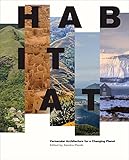Habitat : vernacular architecture for a changing planet / edited by Sandra Piesik
Contributor(s): Piesik, Sandra [editor].
Publisher: New York, NY : Abrams, 2017Description: 600 pages : color illustrations, color maps ; 37 cm.Content type: text | still image Media type: unmediated Carrier type: volumeISBN: 9781419728808.Subject(s): Sustainable architecture | Vernacular architecture -- Environmental aspects | Climatic changes | ClimatologyGenre/Form: Print books.| Current location | Call number | Status | Date due | Barcode | Item holds |
|---|---|---|---|---|---|
| On Shelf | NA208 .H33 2017 (Browse shelf) | Available | AU00000000012139 |
Browsing Alfaisal University Shelves , Shelving location: On Shelf Close shelf browser

|

|

|

|

|

|

|
||
| NA204 .A64 2017 Architectural guide. | NA204 .A64 2019 Architectural guide Rome : buildings and projects after 1945 / | NA208 .D53 2017 Dialectic V : the figure of vernacular in architectural imagination / | NA208 .H33 2017 Habitat : vernacular architecture for a changing planet / | NA209 .C73 2017 Fallen glory : the lives and deaths of history's greatest buildings / | NA209.5 .T35 2016 The tale of tomorrow : utopian architecture in the modernist realm / | NA212 .L45 2011 A dictionary of ancient Near Eastern architecture / |
Includes bibliographical references (pages 575-581) and index
Foreword / Tomasz Chruszczow -- Introduction / Sandra Piesik -- The Influence of Climate on Building Design and Materials / Catherine Souch -- A Geological Classification of Earth Materials in Vernacular Construction / Graham Lott -- Plants in the Built Environment / William Miliken -- An Anthropologocal Introduction to Vernacular Architecture André Singer -- The Value of the Vernacular / Jim Coleman Henry Fletcher -- Tropical -- Dry -- Temperature -- Continental -- Polar -- Appendix 1: Contemporary Vernacular -- Appendix 2: Natural Disasters -- Appendix 3: Materials Science
Vernacular architecture is architecture without architects; designed based on local needs, these buildings make use of natural resources and demonstrate diverse architectural forms, design elements unique to their culture, and ingenious construction techniques. From bamboo garden pavilions in China to homes made from reeds in southern Iraq, and mud dwellings in Mali to pine huts in Siberia, Habitat showcases the diverse and indigenous materials that can be used to build innovative, sustainable structures


